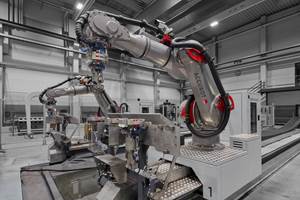National Composites Week 2025: Space
Commemorating the theme “Performance With Purpose,” CW has gathered key stories over the last year that exemplify how composites have progressed space exploration and satellite programs.

Source (clockwise) | Firefly Aerospace, MT Aerospace, Rock West Composites
As unfolds this year and we discuss the ways in which composites exemplify “Performance With Purpose,” an exciting area of growth is the space sector. From the rise of carbon fiber rocket platforms to the proliferation of constellation satellites, the growth over the past 5 years has been explosive. According to a recent installment of The Space Report presented by the Space Foundation, space workforce employment grew by 18% between 2019 and 2024. Commercial companies are actively partnering with space agencies like NASA and the European Space Agency (ESA) in ever-evolving ways, with composites enabling a variety of mission-enabling parts and structures including launch systems, landing struts, load-bearing structures, propulsion systems, thermal protection systems (TPS), telescoping arrays on satellites and many others.
Meanwhile, NASA’s Artemis program, which features many enabling composite technologies, has had numerous successful missions — small steps setting the stage for returning humans to the moon. An exciting time, indeed.
National Composites Week is fitting moment to look ban the year’s progress in this constantly growing area. Below is a roundup of key content to explore, read and learn more.
Note: Below covers only articles produced in 2025 for these topics. For other related content (including news and products), visit these sections of our website.
Ultrasonic welding for in-space manufacturing of CFRTP
Agile Ultrasonics and NASA trial robotic-compatible carbon fiber-reinforced thermoplastic ultrasonic welding technology for space structures.
Revolutionizing space composites: A new era of satellite materials
A new approach for high volumes of small satellite structures uses low-CTE, low-cost CFRP cellular core, robust single-ply skins and modular panel systems to cut lead time, labor and cost for reflectors, solar arrays and more.
Episode 50: Markus Rufer, Scorpius Space Launch Co.
In this episode of CW Talks, CW interviews Scorpius Space Launch Co. CEO Markus Rufer about the company’s all-composite cryogenic pressure vessels and their role in a range of applications, including recent and upcoming lunar lander missions.
A return to the Space Symposium: Charting the next frontier
Since 2019 the space sector has been on a rapid upward trajectory. This year’s Space Symposium delivered that same optimism, celebrating the community’s continued proliferation, even as political and financial uncertainty raise new questions.
CIRA qualifies CMC structures for the reusable Space Rider
Italian team designs, builds and tests multiple large, complex thermal protection system structures made from patented ISiComp C/C-SiC ceramic matrix composites.
Composites end markets: New space (2025)
Composite materials — with their unmatched strength-to-weight ratio, durability in extreme environments and design versatility — are at the heart of innovations in satellites, propulsion systems and lunar exploration vehicles, propelling the space economy toward a $1.8 trillion future.
Ceramic matrix composites: Faster, cheaper, higher temperature
New players proliferate, increasing CMC materials and manufacturing capacity, novel processes and automation to meet demand for higher part volumes and performance.
Optimizing a CFRP landing leg demonstrator
MT Aerospace achieves design for manufacturing, integrating multiple elements into one-piece structure using AFP and 3D printed tooling to meet time and budget constraints.
Composites business growth through diversification, innovation
San Diego-based 2024 Top Shops qualifier Rock West Composites gives an overview of its relentless commitment to improvement, including its composite capabilities and its role as a trusted player in the space market.
Carbeon C/C-SiC ceramic matrix composites without fiber coating
Dutch startup Arceon is working with leaders in space, hypersonics and industry to test its Carbeon CMC, validating near-net-shape parts with <3% porosity and performance at 1600ºC, targeting UHTCMC and a presence in the U.S. in 2025.
Related Content
Rocket Lab begins installation of large AFP machine for rocket production
The 99-ton AFP machine, custom-designed and built by Electroimpact, is claimed to be the largest of its kind, expecting to save around 150,000 manufacturing hours in the Neutron rocket’s production process.
Read MoreOptimizing a CFRP landing leg demonstrator
MT Aerospace achieves design for manufacturing, integrating multiple elements into one-piece structure using AFP and 3D printed tooling to meet time and budget constraints.
Read MoreAutomated robotic NDT enhances capabilities for composites
Kineco Kaman Composites India uses a bespoke Fill Accubot ultrasonic testing system to boost inspection efficiency and productivity.
Read MoreCall for abstracts: CW Tech Days to explore high-temperature composite solutions
The fall 2025 installment of CW’s Tech Days online event series will cover high-temperature composite solutions for defense and space applications.
Read MoreRead Next
Ultrasonic welding for in-space manufacturing of CFRTP
Agile Ultrasonics and NASA trial robotic-compatible carbon fiber-reinforced thermoplastic ultrasonic welding technology for space structures.
Read MoreCutting 100 pounds, certification time for the X-59 nose cone
Swift Engineering used HyperX software to remove 100 pounds from 38-foot graphite/epoxy cored nose cone for X-59 supersonic aircraft.
Read MoreScaling up, optimizing the flax fiber composite camper
Greenlander’s Sherpa RV cab, which is largely constructed from flax fiber/bio-epoxy sandwich panels, nears commercial production readiness and next-generation scale-up.
Read More












